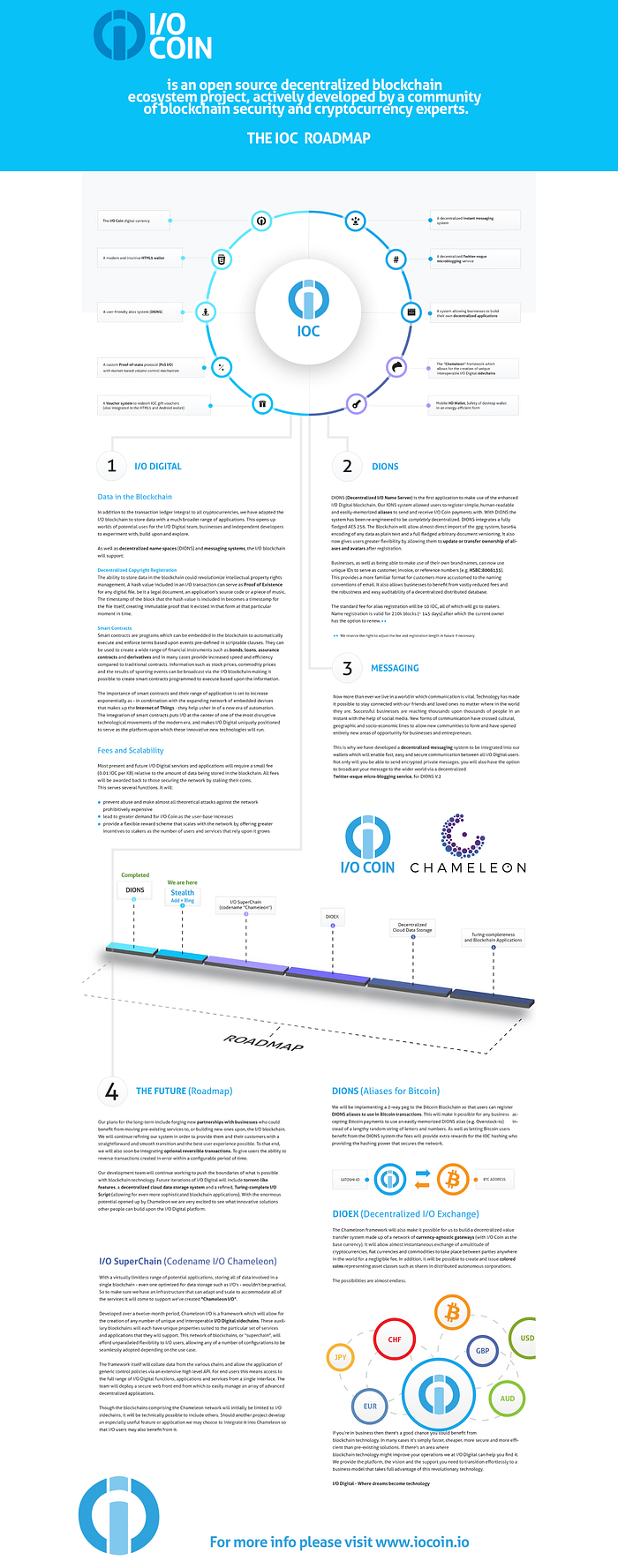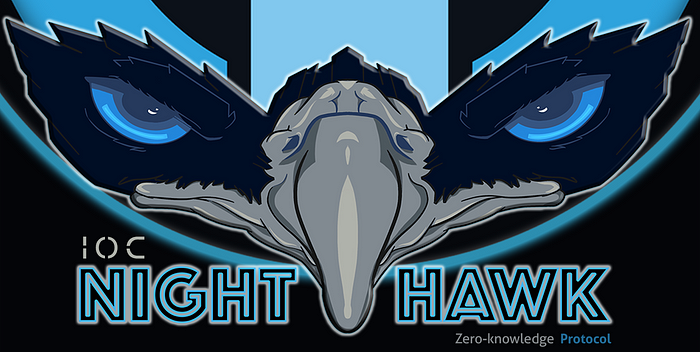I/O Coin a Proof Of Stake Blockchain since 2014
On the road to success….
How do we measure success of a crypto project? Do we measure it by market cap, influencers, ico funding, roi, or how about technological achievements?
Which ever may be your answer, I measure success of a crypto project by the ability of a community to be relentless in completing set goals. This through hard work and dedication against all odds, even through budgeting limitations. And that’s exactly what the iOC Dev team and community have been doing.

As the story goes, on July 24th 2014 the iOC Dev team and community set themselves out on a journey of proving one of the most daunting questions in crypto history and that was the viability of a new proposed blockchain security protocol in (POS) Proof of Stake.

The first goal for the team was to ensure a successful switch over from POW to POS. The POW-X11 mining period, was chosen in order to fairly and properly distribute the initial set of iOC. This POW/POS switch did not require a hard fork but the switch was schedule to occur 2 weeks into the mining period on the fly. This was one of many points that could have doomed the project, right out of the gate. As block 24400 was approaching it was all eyes on deck, but the the switch over was a success and iOC’s algorithm was officially switched over from POW to POS. As the dev team saw success with the POW period switch over, a mission statement was released on August 4, 2014 for the long term plans of the project.

In the statement there were 3 key points that the team was setting out to accomplish.
1. Ease of Use via wallet UI switching from Bitcoin QT to a full HTML5 Wallet
2. Creating a semi-centralized name server or alias codename (ions)
3. Ensuring the viability of Proof of Stake

Unlike proof of work, back in 2014, standard POS models required staking wallets (coins held for confirming transactions) to be fairly balanced as any one wallet with a few million coins staking would have thrown off smaller weighted nodes from staying in sync, which would have caused multiple un wanted forks. Therefor making it impossible for the chain to stay in proper sync, while also generating massive amounts of orphans. As part of making POS more balanced the team opted to remove coinage, an inherited feature from Peercoin.
Along with other enhancement, this move allowed for a more fair and balanced reward system. The priority was to achieve full decentralization faster by eliminating the 30 day mature period. During this time stakers would be working but would never sign a block through stake. This improvement among other technical upgrades, allowed the iOC team to introduce their own flavor codenamed POS I/O an upgrade from POS 2.0
The switch from POW to POS occurred without any glitch on August 8th, 2014.

As the blockchain was stabilizing the team released their first whitepaper on IONS (input output name server). IONS was calling “to create a system which could be directly implemented into I/OCoin’s normal operations, where arbitrary strings, hence-forth referred to simply as “usernames”, could be easily associated with Base58-encoded addresses.”

IONS was implemented via QT wallet and was released successfully.

As par of te overall push to upgrade the QT Bitcoin Wallet, which was already adapted to enable staking, the team set themselves out to redesign it and implemented a new Html5 UI frontend.
This unique take was not based on the Bitcoin QT UI and by October 8, 2014, the team released a new HTML5 UI with interchangeable skin designs, which was a first for a POS blockchain cryptocurrency. IONS was also implemented successfully into the Html5 wallet UI.


Continuing on the road to success 2015 through 2019


After a successful completion of iOC’s original mission statement goals, other projects continued to have appetite for POW. Continuing the trend of video cards and miners for projects like Ethereum, raising millions for development and sucking up much of the development talent. Essentially changing the space from mostly donated work to paid. And as devs were lured for great pay days, the iOC team doubled down and in 2015 introduced a new roadmap.
The Roadmap was even more aggressive. The iOC whitepaper proposed an upgrade to IONS and was deemed codename DIONS (decentralized input output name server). Data on the blockchain, Messaging, interoperability for DIONS with BTC, DIOEX and Chameleon.
The initial focus was to ensure all IONS would be fully decentralized, moving away from needing servers. Furthering on this, the team also wanted to enable full on data pairing with all DIONS.
To ensure this would be safe for all, the team enabled full on AES256 encryption, capping data at 1MB. Enough to upload a 500 page book, to deeds, tittles and other files like copyrights. In addition and looking towards the future, AES256 encrypted messaging was also put forward. All this was definitely a big challenge, but the team tackled the code and continued to push the boundaries into uncharted waters for the Proof of stake algorithm.
Throughout the better of 2015 through 2017 the team was full time coding and testing all of the code for DIONS. Special virtual environments were set to recreate numerous scenarios which allowed for the team to make things even more secure and robust. And as smart contracts were starting to take off, the iOC dev team did not deviate. Instead the focus was on having a robust platform, one that would be able to integrate a set of features without centralizing or adding any comprising 2nd software layer. For that reason, all features were designed to be completely baked into the code without the need of any third party software layers or weak smart contract layers. This would eliminate all potential security threats posed by smart contract layers. Many who at the time were being gained, essentially making assets vulnerable to 2nd layer attacks. The team was also straight forward in that the future would not be defined by 1 single blockchain but by a multiverse of chains inter changing data via interoperable 2 way pegs.
Through the coding process the team was being acknowledged for different awards from benzinga, european fintech 100 and Fintech 100 by KPMG

In 2016 The I/O digital foundation was also setup in order to help with curating the iOC blockchain code, engage with potential partners and to push donations with iOC community members to help different causes, including iOC conferences.




In late 2017 the iOC Dev team introduced a fully revamped DAPP wallet system. The UI was set to accommodate all the new DIONS features. Although it proved to be a big challenge moving from a single feature to a multi feature wallet, the team was able to make it all work. This was another battle and goal met by the team. The wallet system was a fully decentralized wallet, which enabled all the features that were available in the QT, the original HTMl5 wallet and all the DIONS features. The team was also able to streamline calls to the daemon in order to further optimize it while at the same time keeping it a fully stakable.


This was the first DAPP wallet in the market. Making it fully accessible to all decentralized features on the iOC Blockchain without requiring the need of a smart enabled contract. The iOC Blockchain was also enabled for identity storage, via Private and Public identities. The dapp wallet gave users the option to store their own personal identification and allowed for the user to be in full control of who could view and share their attachment files or identities. The avatar creation also allowed for storing art and pictures. Deeds, copyrights, trademarks, proof of ownership, data and much more. All of which utilized the highest levels of encryption in AES256.

Private and Public identities were enabled to be fully transferable between users. Also giving the ability for users to send iOC via Usernames. This base seats ready and in the near future, a full DNS service can also be enabled.
Private identities enable users to attach an upload any 1MB File to the iOC blockchain. Users are also able to transfer identities and documents to other users all while maintaining a fully encrypted tunnel. These features extend to IOT devices which could also access them via API
Find below a video demonstration on iOC’s data storage capabilities through the iOC Dapp Wallet.
In addition to iOC’s data capabilities which extend to IOT’s via api, the team also enabled AES256 Encrypted messaging.
As the battle of centralized messaging platforms was getting started, attacks on citizens from around the world were also increasing and being people began to be persecuted for simply voicing their opinions via chat. Telegram, twitter and other centralized platforms, were shadow banning accounts and even terminating user accounts. Today the attacks continue. US government officials are now moving to pass laws which would give the government backdoors to encrypted data. This would affect companies who are hosting encrypted data like Facebook, Apple,WhatsApp, Telegram and others.
With this in mind thinking of a future were peoples ability to communicate would be interrupted and spied on, the team wanted to ensure that in the event any of these companies would violate peoples freedom of speech, users would have an actual decentralized platform were they could continue to communicate. Today we still have people in many countries who are being persecuted for their political views. The team felt it was important to protect peoples privacy and therefor made sure that messages would only be assessable to the communicating parties. Since iOC is a decentralized open source platform there is no way for any developer or even the foundation to stop or provide any service to decrypt data. In iOC’s case, only the end user who holds a private key could do such a thing.
Offering this upgrade was a strong accomplishment an a first in crypto with this level of encryption and speed to confirm encrypted decentralized messages on a blockchain.
Stealth Addresses + Shuffle Staking
The I/O Coin development team also worked hard in expanding DIONS by deploying 2 essential upgrades.
- Stealth addresses provided another layer of privacy to iOC users. The team deployed Send and receiving of shade payments was implemented into the wallet giving users an optional way of sending private payments. Exchanges can chooses to upgrade or pass on this feature since is not a forced feature. Stealth addresses went live on Block 1898337.

Having stealth addresses added to private aliases, encrypted storage and messaging paved the way for what the team was planning for their future major upgrade which would ensure a complete ecosystem of added privacy to their interactions within the iOC blockchain.
2. Shuffle Staking provided an even more fair and balanced reward system too low weighted stakers. The change in code gave low weighted stakers a chance to be reward via shuffle even if their weight in coins was low to the rest of the stakers. In the past and in many POS blockchains these rewards are only given if a user has a set amount of coins in stake.

The North American Bitcoin conference January 18, 2019 Booth



Chameleon was formally announced On January 18th 2019 at the North American Bitcoin Conference. During the presentation the team released the Chameleon whitepaper. Details of chameleon were first thought of back in 2015, but the team didn't want to push it forward to ensure iOC’s POS viability.
With Chameleon the team will offer solutions too many malleabilities that plagued most of the well known Blockchain projects today. Many of the ones who for years downplayed the importance of POS. Now today are running to give their projects added security and greater decentralization. And as much as this is a great shot of confidence for the POS algorithm, we still have to see what flavor of POS they will deploy. It will certainly take years to properly test, if their choices in code are valid and not riddle with security holes.
For the iOC team this question has been put to rest, and the team is now looking to the future. The vision is set to do a full POS algorithm upgrade with a proposed entropy based graph ledger. Chameleon just like iOC, will also be a scientific project to address interoperability, scalability while facilitating maximum (Tps) transactions per second. This will also serve as a solid base for the proposed abstract smart contract layer. In addition to the Cham SDK making it a more versatile and secure option for Defi. Chameleon will also lend itself to be the bridge for multiple platforms. By offering exclusivity to access all of iOC’s privacy payments, encrypted messaging and file storage features via SDK. Chameleon will reward all iOC stakers with a bonus based on iOC staking weight and chameleon graph ledger uptime. All final features will be released at chameleon’s up coming offering.
But before Chameleon’s offering is officially announced the team is currently focused on releasing the much anticipated upgrade for iOC in NightHawk protocol.
Continuing on the road to success 2020 and Beyond
The Night Hawk upgrade + Features are currently on hold, team is focused on Dions Virtual Machine to be deployed first. Thank You


(Nighthawk is 90% completed but the team has held it back for now in order to deploy our DVM Solidity compatible smart contracts. We will revisit NH at a later more strategic point updated 12/6/2021)

Just as banks attempt to safeguard customer transactional data, fundamental protections should be afforded to all cryptocurrency users. In the last few years, we have seen an increase in sophisticated attacks, intrusions, and third-party trackers into Bitcoin and other cryptocurrency applications. Having access to this sensitive public information has embolden bad actors to even track users whereabouts in order to steal their cryptocurrency holdings. These shortcomings have put a spotlight on total privacy for all people.
For these reasons the iOC dev team will lead the way by further enhancing its currently live and robust privacy features. The team is currently developing on their own Zero knowledge protocol codename (NightHawk) and will be fortifying the coins privacy by encrypting user balances and adding ring signatures to all transactions. Ring sigs will be default to 5 with up to 30 rings. Balances will only be known by the sender and receiver. Making staking balances also fully private. To this upgrade the team will also add cold sig, orphan pruning tool, graduated staking and a POS reward halving.

As you have read, iOC has been a project on a road to success since its genesis block, on July 24th, 2014. The project has successfully completed 52,560 hours of interrupted transactions with almost 3 Million POS blocks. Since day one the entire iOC team, community and foundation have been fully committed to pushing the boundaries of decentralized systems by also making it’s native cryptocurrency one to be fortified by it’s unique POS Cipher along with all it’s in line privacy features.
To the iOC Community;
It has been my pleasure to have represented you and to have witnessed the relentless effort of many of my colleagues who have graced this project with their unique cryptographic talents. Thank you to everyone who has contributed countless amounts hours to making iOC such a great project. It has in deed been many years, full of sacrifices, but looking back, iOC is one of the most solid, fair launched projects in crypto history. It was not easy to have bet on POS, specially when the crypto world thought it was bound to fail. And although the team looked into a very unknown future, along with the community who supported and believed in the trajectory, to this day, we continue to witness iOC on its road to success.
Stay tuned, More to come
here is our latest updated report on I/O Coin ⬇️
Beyond Bitcoin and Ethereum: Uncovering the Potential of I/O Coin

Happy 9th Birthday iOC — — — — GOD SPEED!
updated on July 24th 2023.
Joel Bosh
Founder
